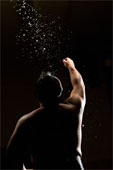The rules of sumo are simple:
The first rikishi (wrestler) who can get his opponent to touch the ground with any part of his body other than the bottom of his foot, or step outside the ring, wins.
The area where a bout takes place is called the dohyo. This is a raised stand, square, a couple of feet high, made of a hard packed clay. Atop it is painted a ring. The two contenders begin on opposite sides of the ring. A referee in fancy dress gives a ceremonial signal and the match begins.
The initial thrust, called the tachiai (pronounced tah-chee-eye), can be very fast. The distance between the contenders is narrow. Often, one will come at another with slapping the face and chest.
Slapping is allowed; however, punching with a fist is not. The mawashi (the diaper-like garment) is fair game for pulling, and some of the strongest techniques for victory involve one rikishi grabbing his opponent's mawashi with both hands and shoving him out of the ring or to the ground.
In fact, almost anything is fair game besides punching. The exception to this is the top-knot, or chonmage. Any grabbing of the top-knot is off limits.
A sumo wrestler has to be fast and strong to win, and often times the victory goes to the man with the best balance. Even if a rikishi outweighs his opponent by as much as a hundred pounds, his victory is not assured if the smaller man has exceptional balance.
Then again, there's the risk that no matter how good the balance, the stronger man can wrap his arms around the weaker one and hoist him off the ground, tip him sideways and throw him down.
Now that's something fans of American wrestling can get into.
Tuesday, April 6, 2010
Subscribe to:
Post Comments (Atom)


No comments:
Post a Comment